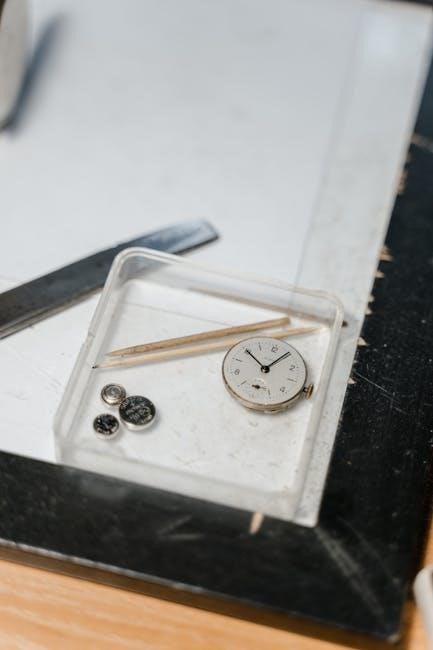Emperor Grandfather Clock Manual: A Comprehensive Guide
Welcome to your comprehensive guide for Emperor Grandfather Clocks! This manual provides everything needed, from assembly and operation to troubleshooting and maintenance. It ensures timeless beauty and accuracy for your cherished timepiece.
Emperor Grandfather Clocks represent a blend of timeless craftsmanship and elegant design, becoming cherished heirlooms passed down through generations. These clocks, often assembled from kits, offer a unique opportunity to create a personalized timekeeping masterpiece. This comprehensive manual serves as your guide to understanding, assembling, and maintaining your Emperor Grandfather Clock, ensuring years of accurate timekeeping and aesthetic pleasure.
Whether you are a seasoned clock enthusiast or a first-time assembler, this guide provides step-by-step instructions, troubleshooting tips, and maintenance advice. You will gain valuable insights into the inner workings of your clock. From setting the chimes to oiling the movement, this resource equips you with the knowledge needed to keep your Emperor clock running smoothly and looking its best.

Understanding Emperor Clock Movements
Delve into the mechanics of Emperor clocks. Understand the heart of your timepiece by exploring different movement types. Learn about their intricate designs, ensuring accurate timekeeping for years.
Identifying Your Movement Type (e.g., 100M, 199M, 200M, 248A, 299M, 300K)
Identifying your Emperor clock movement is crucial for proper maintenance and repair. Common types include 100M, 199M, 200M, 248A, 299M, and 300K. Each movement has unique characteristics and operational nuances. Look for markings on the movement itself, usually on the back plate or side. These markings often include the model number and manufacturer information.
Consulting your original Emperor Clock documentation is also beneficial, but if unavailable, online resources and forums dedicated to clock repair can assist in identification. Correct identification will allow you to source the correct parts and service instructions.
Knowing the movement type is essential for troubleshooting issues.
Hermle Movement Identification and Cross-Reference
Many Emperor Grandfather Clocks utilize Hermle movements, renowned for their quality and precision. Identifying your Hermle movement involves locating the model number stamped on the back plate. Common identifiers include numbers like 451-050H, often accompanied by a length specification (e.g., 94cm/66). These numbers are crucial for finding specific repair parts and service information.
Cross-referencing your Hermle number with Emperor Clock documentation or online resources is essential. Since Hermle supplied movements to various clockmakers, understanding the specific Emperor model associated with your Hermle movement will ensure that you get the correct instructions.
This will help you determine the correct parts and procedures.
Installation Instructions
Detailed installation instructions, specific to your Emperor clock model, are crucial. Carefully study diagrams and follow each step for safe assembly, ensuring proper function of your cherished timepiece.
Step-by-Step Assembly Guide (Based on Kit Model)
Assembling your Emperor Grandfather Clock kit requires meticulous attention to detail. Begin by carefully unpacking all components and cross-referencing them with the provided parts list. Identify each piece before starting the assembly process. Refer to the assembly manual specific to your kit model (e.g., 300K Cambridge, 120K, 145K) for detailed diagrams and instructions.
The manual will guide you through the step-by-step construction of the clock case, including the waist and hood. Pay close attention to the order of assembly and the correct placement of each component. Ensure all screws and fasteners are properly tightened, but avoid over-tightening, which could damage the wood. The hood back should await installation of the clock movement.
Mounting the Movement and Chime Rods
Carefully position the movement mount inside the clock case, ensuring it is level and securely fastened. The movement should be handled with care to avoid damage to the delicate components. Refer to the manual for the correct mounting orientation. Once the mount is secure, gently place the clock movement onto it.
Next, attach the chime rods to the movement according to the manual’s instructions. Ensure that each rod is properly aligned and secured to produce the correct chime sequence. Improperly installed chime rods can result in muffled or incorrect chimes. Double-check all connections before proceeding.
Pendulum and Weight Installation
Carefully unpack the pendulum and weights. Handle them with care to avoid scratches or dents. Consult the manual to identify the correct weight for each side (left, center, right). Typically, heavier weights go on the outside.
Gently hang the weights onto their respective chains or cables, ensuring they are securely attached. Next, hook the pendulum onto the pendulum leader, ensuring it swings freely without obstruction. Give the pendulum a gentle push to start the clock. Listen carefully for a consistent “tick-tock” sound, indicating proper operation. Adjust the clock’s leveling if needed to achieve this consistent rhythm.
Operating Instructions
This section details how to set the time, activate the chime sequences, and utilize any special features your Emperor clock offers. Follow these instructions for optimal performance and enjoyment.
Setting the Time and Chimes
To accurately set the time on your Emperor grandfather clock, gently move the minute hand clockwise. Avoid moving it counterclockwise, as this could damage the delicate movement. When setting the time, allow the clock to chime each quarter hour so it can properly synchronize. If you need to move the time forward significantly, advance the minute hand slowly, pausing at each quarter hour. For the chime sequence, consult your movement’s manual for specific instructions. Some models allow you to select different chimes, like Westminster, Whittington, or St. Michael’s. Ensure the chime selector is positioned correctly for your desired melody. Regular synchronization ensures your clock remains a reliable and beautiful timepiece.
Activating Night Shut-Off (If Applicable)
Many Emperor grandfather clocks feature a night shut-off function, designed to silence the chimes during specified hours, typically in the evening and early morning. To activate this feature, locate the night shut-off lever or switch, usually found on the clock’s dial or movement. Consult your clock’s manual for its precise location and operation. Move the lever to the “on” or “silent” position to engage the night shut-off. This will prevent the clock from chiming during the designated period, ensuring a peaceful night. Remember to disengage the night shut-off lever in the morning to resume the regular chime sequence. If unsure, always refer to the specific instructions in your Emperor clock’s manual. Proper use extends the chime mechanism’s life.

Troubleshooting
Encountering issues with your Emperor Grandfather Clock? This section addresses common problems like inaccurate timekeeping, chime malfunctions, and pendulum issues. Find solutions to keep your clock running smoothly.
Common Issues and Solutions
This section dives into frequent problems encountered with Emperor Grandfather Clocks. One common issue is the clock stopping, often due to improper leveling. Ensure the clock is perfectly level using a spirit level, adjusting the feet as needed. Another frequent problem is incorrect chiming, which can arise from misaligned chime rods or a faulty chime sequence setting. Refer to the movement-specific manual for correct chime rod placement and adjustment procedures.
Furthermore, timekeeping inaccuracies can be caused by pendulum length or environmental factors. Adjust the pendulum bob to fine-tune the clock’s speed. If problems persist, consider professional repair services.
Adjusting Timekeeping Accuracy
Maintaining accurate time is crucial for your Emperor Grandfather Clock. If your clock runs fast, lower the pendulum bob slightly to lengthen the pendulum’s effective length, slowing the clock down. Conversely, if your clock runs slow, raise the pendulum bob to shorten the pendulum’s effective length, speeding the clock up. Make small adjustments and observe the clock’s performance over several days before making further changes.
Environmental factors, such as temperature and humidity, can also affect timekeeping. Ensure the clock is placed in a stable environment. Persistent inaccuracies may indicate a need for professional servicing or cleaning to remove dust buildup that can affect movement.

Maintenance
Proper maintenance ensures your Emperor Grandfather Clock lasts for generations. Regular cleaning, oiling, and chain/cable care are vital. Follow these guidelines to keep your clock in optimal condition and preserve its value.
Oiling and Cleaning Procedures
Maintaining your Emperor Grandfather Clock involves careful oiling and cleaning to ensure smooth operation and longevity. Use a high-quality clock oil sparingly on the movement’s pivot points, following the manufacturer’s recommendations. Avoid over-oiling, as this can attract dust and debris, hindering performance.
For cleaning, gently dust the clock case with a soft cloth, avoiding harsh chemicals or abrasive cleaners. Pay special attention to intricate carvings and details. The dial can be carefully cleaned with a slightly damp cloth, ensuring no moisture enters the movement. Regular maintenance prevents buildup and preserves the clock’s aesthetic appeal.
Chain or Cable Maintenance
Proper maintenance of the chains or cables is essential for the reliable operation of your Emperor Grandfather Clock. Regularly inspect the chains or cables for signs of wear, such as fraying, kinks, or rust. If you notice any damage, replace them immediately to prevent breakage and potential damage to the movement.
To maintain smooth operation, lightly lubricate the chains or cables with a dry lubricant specifically designed for clocks. Avoid using oil, as it can attract dust. Ensure the chains or cables are properly aligned on the sprockets or pulleys, preventing them from slipping or binding. Consistent maintenance extends their lifespan.

Accessing Manuals and Resources
Find replacement instructions and manuals online for your Emperor clock, Hermle movement, or kit assembly. Discover resources to ensure the proper care and longevity of your cherished timepiece.
Locating Replacement Instructions and Manuals Online
Lost your original Emperor Grandfather Clock manual? Don’t worry, replacement instructions and manuals are often available online. Start by checking the Emperor Clock Company website, if it is still active. Many online clock repair and parts suppliers also maintain archives of manuals for various clock movements, including Hermle.
Include the movement number (e.g., 100M, 199M, 299M) in your search query to narrow down the results. Online forums and clock enthusiast communities can also be valuable resources for locating specific manuals or obtaining advice from experienced owners. Remember to check reputable sources and verify the information before applying it to your clock.